Exploitation of Large Archives of ERS and ENVISAT C-Band SAR Data to Characterize Ground Deformations
Abstract
:1. Introduction
2. SAR Datasets, Processing Techniques and Product Accuracy
3. Application of A-DInSAR to Understanding Ground Deformation Dynamics
3.1. Central Umbria (Italy)
3.2. Nebrodi, Messina Province (Italy)
3.3. Rácalmás Landslide, Danube Riverbank (Hungary)
3.4. Silesian Coal Basin (Poland)
3.5. Tramuntana Range (Mallorca)
3.6. St. Moritz (Switzerland)
4. Discussion
5. Conclusions
- (1)
- A-DInSAR techniques, regardless of the employed core algorithms, represent effective tools for remotely measuring and investigating ground deformation scenarios, characterized by different mechanism, dynamics and geological/environmental settings;
- (2)
- A-DInSAR techniques, thanks to their capability of analysis at different spatial scales, i.e., from regional to local, have been demonstrated to be suitable for exploring large land areas and identifying high risk zones that may further benefit from deeper analyses;
- (3)
- Very long DInSAR deformation time series play a fundamental role for investigating the dynamics of landslides and subsidence, including those phenomena characterized by non-linear displacement trends.
Acknowledgments
Conflict of Interest
References
- Gabriel, A.K.; Goldstein, R.M.; Zebker, H.A. Mapping small elevation changes over large areas: Differential radar interferometry. J. Geophys. Res 1989, 94, 9183–9191. [Google Scholar]
- Colesanti, C.; Wasoswki, J. Investigating landslides with satellite synthetic aperture radar (SAR) interferometry. Eng. Geol 2006, 88, 173–199. [Google Scholar]
- Meisina, C.; Zucca, F.; Notti, D.; Colombo, A.; Cucchi, A.; Savio, G.; Giannico, C.; Bianchi, M. Geological interpretation of PSInSAR Data at regional scale. Sensor 2008, 8, 7469–7492. [Google Scholar]
- Herrera, G.; García-Davalillo, J.C.; Mulas, J.; Cooksley, G.; Monserrat, O.; Pancioli, V. Mapping and monitoring geomorphological processes in mountainous areas using PSI data: Central Pyrenees case study. Nat. Hazards Earth Syst. Sci 2009, 9, 1587–1598. [Google Scholar]
- Cigna, F.; Del Ventisette, C.; Liguori, V.; Casagli, N. InSAR Time-Series Analysis for Management and Mitigation of Geological Risk in Urban Area. Proceedings of the 2010 IEEE International Geoscience and Remote Sensing Symposium (IGARSS), Honolulu, HI, USA, 25–30 July 2010; pp. 1924–1927.
- Cigna, F.; Del Ventisette, C.; Liguori, V.; Casagli, N. Advanced radar-interpretation of InSAR time series for mapping and characterization of geological processes. Nat. Hazard Earth Syst. Sci 2011, 11, 865–881. [Google Scholar] [Green Version]
- Bonforte, A.; Guglielmino, F.; Coltelli, M.; Ferretti, A.; Puglisi, G. Structural assessment of Mount Etna volcano from Permanent Scatterers analysis. Geochem. Geophys. Geosyst 2011, 12, Q02002. [Google Scholar]
- Crosetto, M.; Monserrat, O.; Cuevas, M.; Crippa, B. Spaceborne Differential SAR Interferometry: Data Analysis Tools for Deformation Measurement. Remote Sens 2011, 3, 305–318. [Google Scholar]
- Bianchini, S.; Cigna, F.; Del Ventisette, C.; Moretti, S.; Casagli, N. Detecting and Monitoring Landslide Phenomena with TerraSAR-X Persistent Scatterers Data: The Gimigliano Case Study in Calabria Region (Italy). Proceedings of the 2012 IEEE International Geoscience and Remote Sensing Symposium (IGARSS), Munich, Germany, 22–27 July 2012; pp. 982–985.
- Ciampalini, A.; Cigna, F.; Del Ventisette, C.; Moretti, S.; Liguori, V.; Casagli, N. Integrated geomorphological mapping in the north-western sector of Agrigento (Italy). J. Maps 2012. [Google Scholar] [CrossRef]
- Cigna, F.; Del Ventisette, C.; Gigli, G.; Menna, F.; Agili, F.; Liguori, V.; Casagli, N. Ground instability in the old town of Agrigento (Italy) depicted by on-site investigations and Persistent Scatterers data. Nat. Hazards Earth Syst. Sci 2012, 12, 3589–3603. [Google Scholar]
- Herrera, G.; Gutierrez, F.; García-Davalillo, J.C.; Guerrero, J.; Notti, D.; Galve, J.P.; Fernández-Merodo, J.; Cooksley, G. Multi-sensor advanced DInSAR monitoring of very slow landslides: The Tena Valley case study (Central Spanish Pyrenees). Remote Sens. Environ 2013, 128, 31–43. [Google Scholar]
- Massonnet, D.; Feigl, K.L. Radar interferometry and its application to changes in the Earth’s surface. Rev. Geophys 1998, 36, 441–500. [Google Scholar]
- Rosen, P.A.; Hensley, S.; Joughin, I.R.; Li, F.K.; Madsen, S.N.; Rodriguez, E.; Goldstein, R.M. Synthetic aperture radar interferometry. Proc. IEEE 2000, 88, 333–382. [Google Scholar]
- Mora, O.; Mallorqui, J.; Broquetas, A. Linear and non-linear terrain deformation maps from a reduced set of interferometric SAR images. IEEE Trans. Geosci. Remote Sens 2003, 41, 2243–2253. [Google Scholar]
- Tomás, R.; Marquez, Y.; Lopez-Sanchez, J.M.; Delgado, J.; Blanco, P.; Mallorquì, J.J.; Martìnez, M.; Herrera, G.; Mulas, J. Mapping ground subsidence induced by aquifer overexploitation using advanced Differential SAR Interferometry: Vega Media of the Segura River (SE Spain) case study. Remote Sens. Environ 2005, 98, 269–283. [Google Scholar]
- Werner, C.; Wegmuller, U.; Strozzi, T.; Wiesmann, A. Interferometric Point Target Analysis for Deformation Mapping. Proceedings of the 2003 IEEE International Geoscience and Remote Sensing Symposium, IGARSS’03, Toulouse, France, 21–25 July 2003; 7, pp. 4362–4364.
- Wegmuller, U.; Werner, C.; Strozzi, T.; Wiesmann, A. Monitoring Mining Induced Surface Deformations. Proceedings of the 2004 IEEE International Geoscience and Remote Sensing Symposium, IGARSS ’04, Anchorage, AK, USA, 20–24 September 2004; 3, pp. 1933–1935.
- Ferretti, A.; Prati, C.; Rocca, F. Permanent scatterers in SAR interferometry. IEEE Trans. Geosci. Remote Sens 2001, 39, 8–20. [Google Scholar]
- Ferretti, A.; Fumagalli, A.; Novali, F.; Prati, C.; Rocca, F.; Rucci, A. A New Algorithm for Processing Interferometric Data-Stacks: SqueeSAR. IEEE Trans. Geosci. Remote Sens 2011, 49, 3460–3470. [Google Scholar]
- Berardino, P.; Fornaro, G.; Lanari, R.; Sansosti, E. A new algorithm for surface deformation monitoring based on Small Baseline Differential SAR interferograms. IEEE Trans. Geosci. Remote Sens 2002, 40, 2375–2383. [Google Scholar]
- Lanari, R.; Mora, O.; Manunta, M.; Mallorqui, J.; Berardino, P.; Sansosti, E. A small baseline approach for investigating deformations on full resolution differential SAR interferograms. IEEE Trans. Geosci. Remote Sens 2004, 42, 1377–1386. [Google Scholar]
- Arnaud, A.; Adam, N.; Hanssen, R.; Inglada, J.; Duro, J.; Closa, J.; Eineder, M. ASAR ERS Interferometric Phase Continuity. Proceedings of the 2003 IEEE International Geoscience and Remote Sensing Symposium, IGARSS ’03, Toulouse, France, 21–25 July 2003.
- Herrera, G.; Fernández, J.A.; Tomás, R.; Cooksley, G.; Mulas, J. Advanced interpretation of subsidence in Murcia (SE Spain) using A-DInSAR data-modelling and validation. Nat. Hazards Earth Syst. Sci 2009, 9, 647–661. [Google Scholar]
- Hooper, A.; Zebker, H.; Segall, P.; Kampes, B. A new method for measuring deformation on volcanoes and other natural terrains using InSAR persistent scatterers. Geophys. Res. Lett. 2004, 31. [Google Scholar] [CrossRef]
- Hooper, A.; Segall, P.; Zebker, H. Persistent scatterer InSAR for crustal deformation analysis, with application to Volcán Alcedo, Galàpagos. J. Geophys. Res. 2007, 112. [Google Scholar] [CrossRef]
- Costantini, M.; Rosen, P.A. A Generalized Phase Unwrapping Approach for Sparse Data. Proceedings of the International Geoscience and Remote Sensing Symposium, Hamburg, Germany, 28 June–02 July 1999; pp. 267–269.
- Costantini, M.; Iodice, A.; Pietranera, L. Temporal Analysis of Terrain Subsidence by Means of Sparse SAR Differential Interferometric Measurements. Proceedings of the Conference on SAR Image Analysis, Modelling, and Techniques EOS/SPIE Symposium on Remote Sensing, Barcelona, Spain, 25 September 2000; pp. 12–18.
- Bonano, M.; Manunta, M.; Marsella, M.; Lanari, R. Long term ERS/ENVISAT deformation time-series generation at full spatial resolution via the extended SBAS technique. Int. J. Remote Sens 2012, 33, 4756–4783. [Google Scholar]
- Pepe, A.; Sansosti, E.; Berardino, P.; Lanari, R. On the generation of ERS/ENVISAT DInSAR time-series via the SBAS technique. IEEE Geosci. Remote Sens. Lett 2005, 2, 265–269. [Google Scholar]
- Righini, G.; Pancioli, V.; Casagli, N. Updating landslide inventory maps using Persistent Scatterer Interferometry (PSI). Int. J. Remote Sens 2012, 33, 2068–2096. [Google Scholar]
- Small, D.; Holecz, F.; Nuesch, D. Combination of Ascending/Descending ERS-1 InSAR Data for Calibration and Validation. Proceedings of the International Geoscience and Remote Sensing Symposium (IGARSS), Firenze, Italy, 10–14 July 1995; 1, pp. 553–555.
- Colesanti, C.; Ferretti, A.; Prati, C.; Rocca, F. Monitoring landslides and tectonic motions with the permanent scatterers technique. Eng. Geol 2003, 68, 3–14. [Google Scholar]
- Chen, J.; Wu, J.; Zhang, L.; Zou, J.; Liu, G.; Zhang, R.; Yu, B. Deformation trend extraction based on multi-temporal InSAR in Shanghai. Remote Sens 2013, 5, 1774–1786. [Google Scholar]
- Tantianuparp, P.; Shi, X.; Zhang, L.; Balz, T.; Liao, M. Characterization of landslide deformations in three gorges area using multiple InSAR data stacks. Remote Sens 2013, 5, 2704–2719. [Google Scholar]
- Casu, F.; Manzo, M.; Lanari, R. A quantitative assessment of the SBAS algorithm performance for surface deformation retrieval from DInSAR data. Remote Sens. Environ 2006, 102, 195–210. [Google Scholar]
- Bonano, M.; Manunta, M.; Pepe, A.; Paglia, L.; Lanari, R. From previous c-band to new x-band SAR systems: Assessment of the DInSAR mapping improvement for deformation time-series retrieval in urban areas. IEEE Trans. Geosci. Remote Sens 2013, 51, 1973–1984. [Google Scholar]
- Felicioni, G.; Martini, E.; Ribaldi, C. Studio dei Centri Abitati Instabili in Umbria; Rubettino Publisher: Soveria Mannelli, Italy, 1994; p. 418. [Google Scholar]
- Marchetti, G.; Martinelli, A. Gli Acquiferi Alluvionali dell’Umbria. In Le Acque Sotterranee in Umbria; Protagon: Perugia, Italy, 1991; pp. 145–167. [Google Scholar]
- Guzzetti, F.; Manunta, M.; Ardizzone, F.; Pepe, A.; Cardinali, M.; Zeni, G.; Reichenbach, P.; Lanari, R. Analysis of ground deformation detected using the SBAS-DInSAR technique in Umbria, central Italy. Pure Appl. Geophys 2009, 166, 1425–1459. [Google Scholar]
- Ardizzone, F.; Basile, G.; Cardinali, M.; Casagli, N.; Del Conte, S.; Del Ventisette, C.; Fiorucci, F.; Gigli, G.; Garfagnoli, F.; Guzzetti, F.; et al. Landslide inventory map for the Briga and the Giampilieri catchments, NE Sicily, Italy. J. Maps 2012. [Google Scholar] [CrossRef]
- Del Ventisette, C.; Garfagnoli, F.; Ciampalini, A.; Battistini, A.; Gigli, G.; Moretti, S.; Casagli, N. An integrated approach to the study of catastrophic debris-flows: Geological hazard and human influence. The case of Giampilieri (Sicily, Italy). Nat. Hazards Earth Syst. Sci 2012, 12, 2907–2922. [Google Scholar]
- Graniczny, M.; Piatkowska, A.; Pilecka, E. An application of the remote sensing technology to the high-energy seismic activity assessment, on the example of the Upper Silesian Coal Basin (USCB). Pol. Geological Inst. Special Pap 2006, 20, 92–98. [Google Scholar]
- Graniczny, M.; Czarnogorska, M.; Jureczka, J.; Kowalski, Z.; Piatkowska, A. Application of PS Interferometry for Identification of Geohazards—Case Study the Upper Silesian Coal Basin. The Abiotic Environment—Evaluation of Changes and Hazards—Case Studies; Abstracts and Field Trip Guide-Book; Centre of Excellence REA, Polish Geological Institute: Warsaw, Poland, 2006; pp. 16–17. [Google Scholar]
- Mateos, R.M.; Azañón, J.M.; Morales, R.; López-Chicano, M. Regional prediction of landslides in the Tramuntana Range (Majorca) using probability análisis of intense rainfall. Zeitung für Geomorphol 2007, 51, 287–306. [Google Scholar]
- Mateos, R.M.; García-Moreno, I.; Azañón, J.M. Freeze-thaw cycles and rainfall as triggering factors of mass movements in a warm Mediterranean región: The case of the Tramuntana range (Mallorca, Spain). Landslides 2011. [Google Scholar] [CrossRef]
- Mateos, R.M.; Bermejo, M.; Hijazo, T.; Rodríguez-Franco, J.A.; Ferrer, M.; de Vallejo, G.; García, I. Los deslizaminetos de la ladera de la margen izquierda del torrente de fiornalutx (Mallorca). Bol. Geol. Min 2008, 118, 385–400. [Google Scholar]
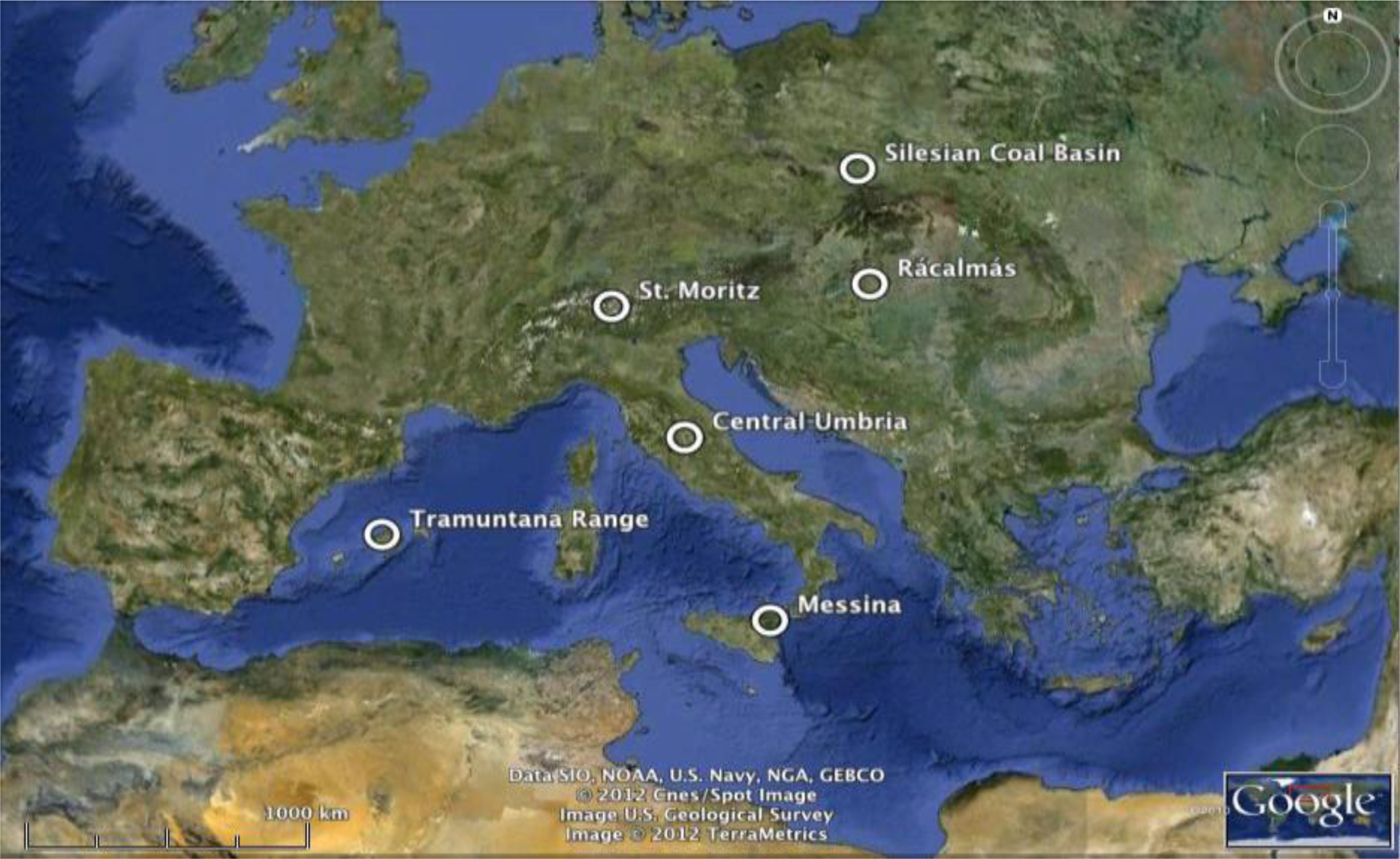


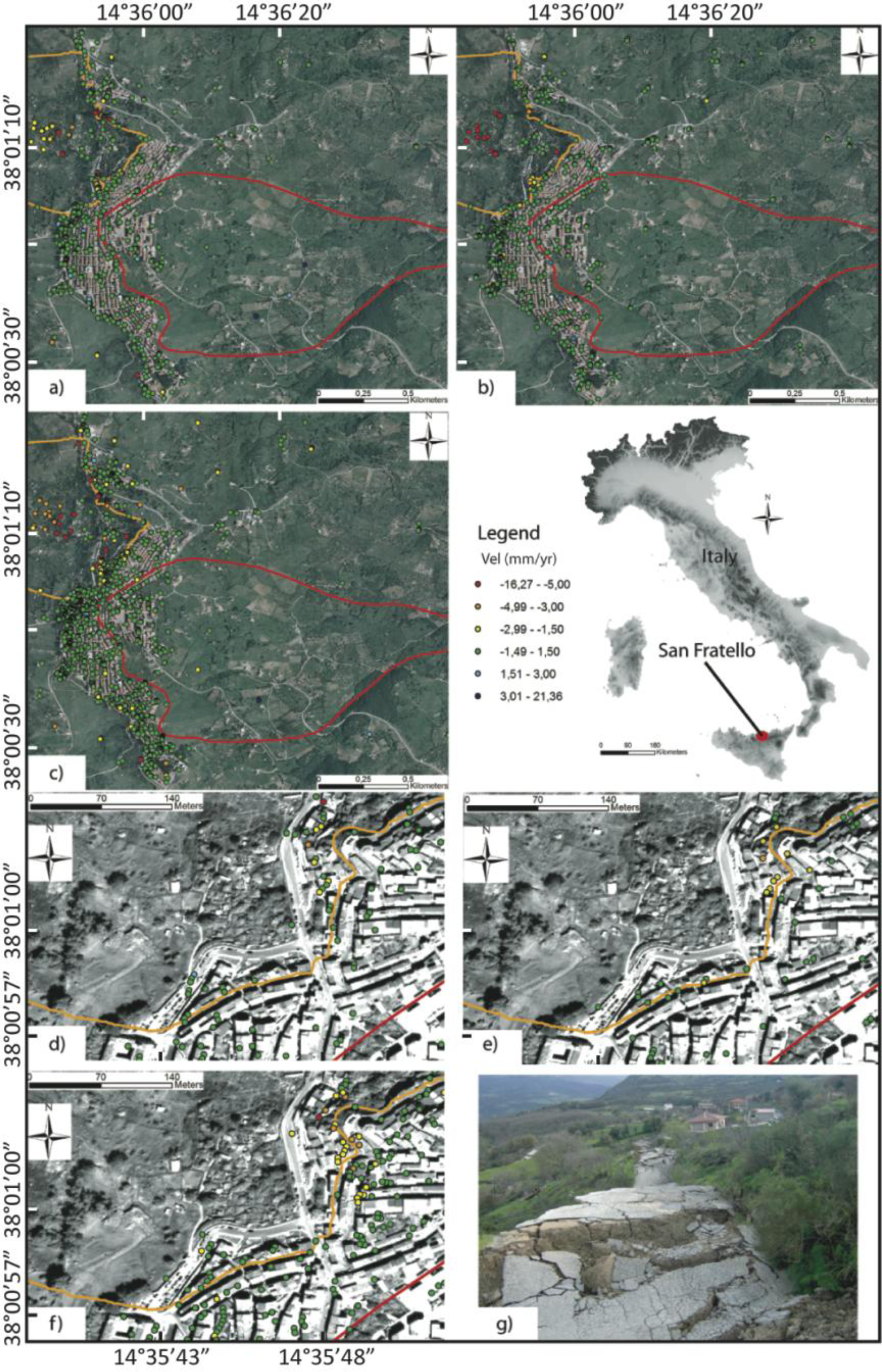
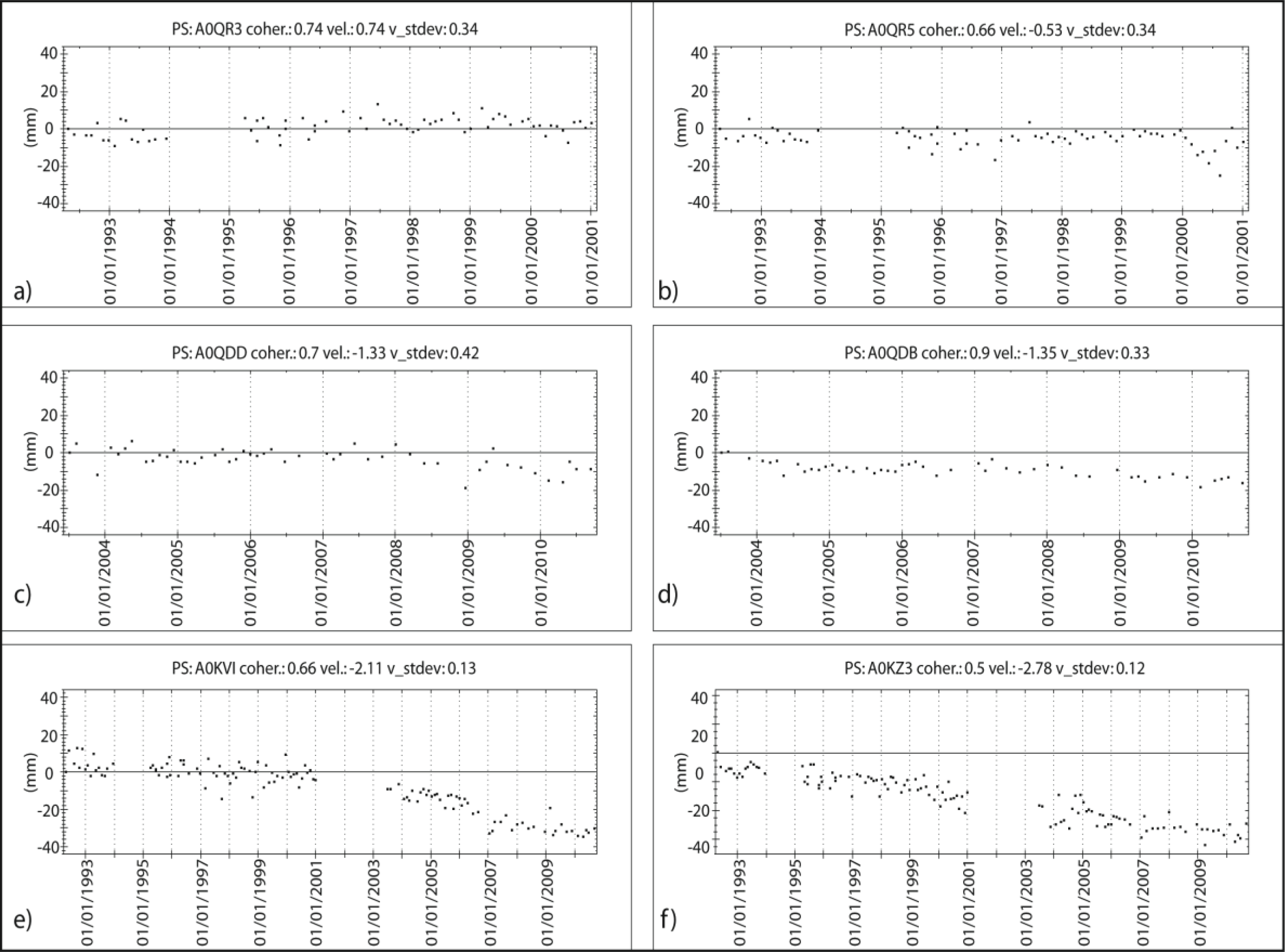
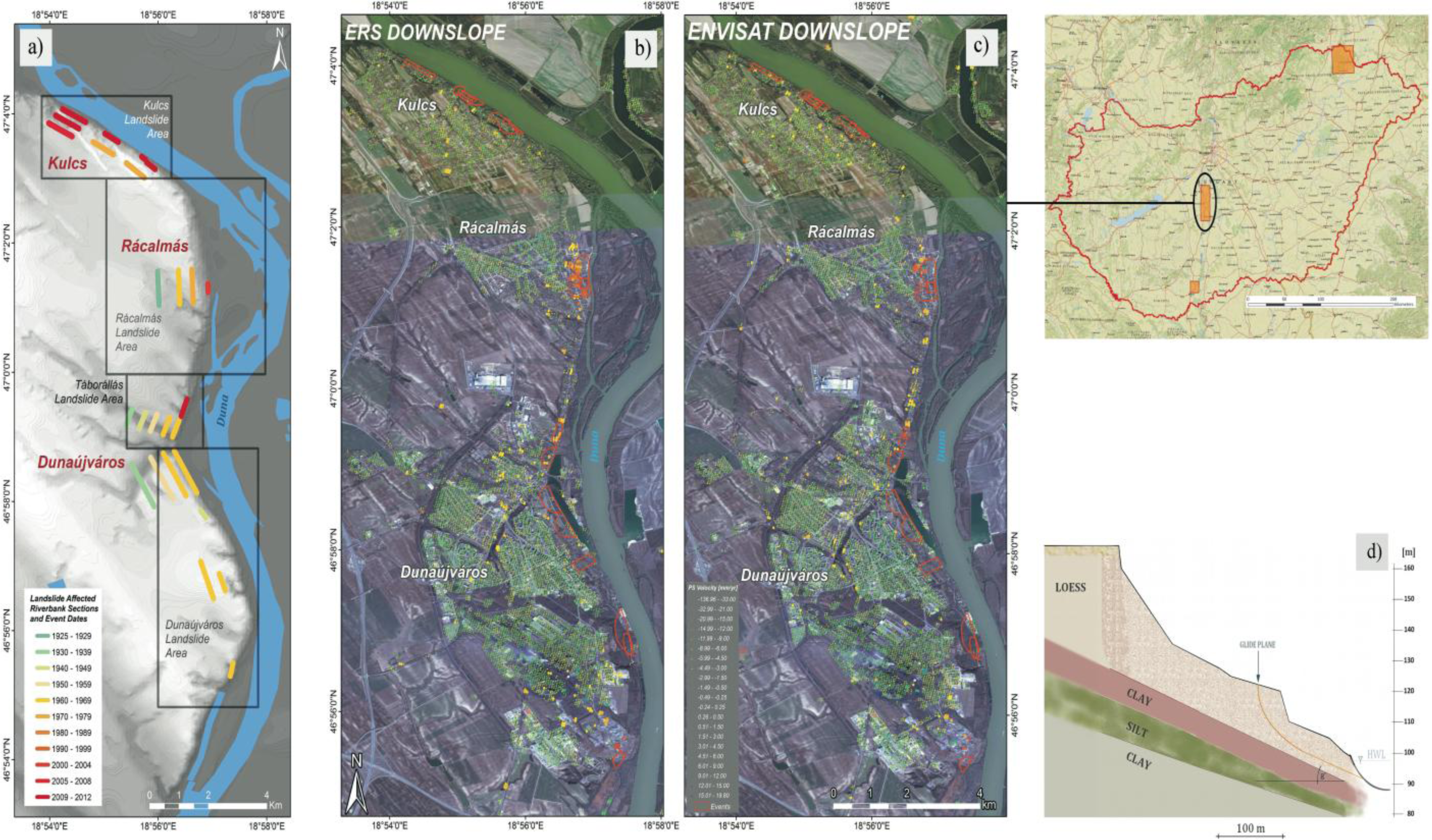
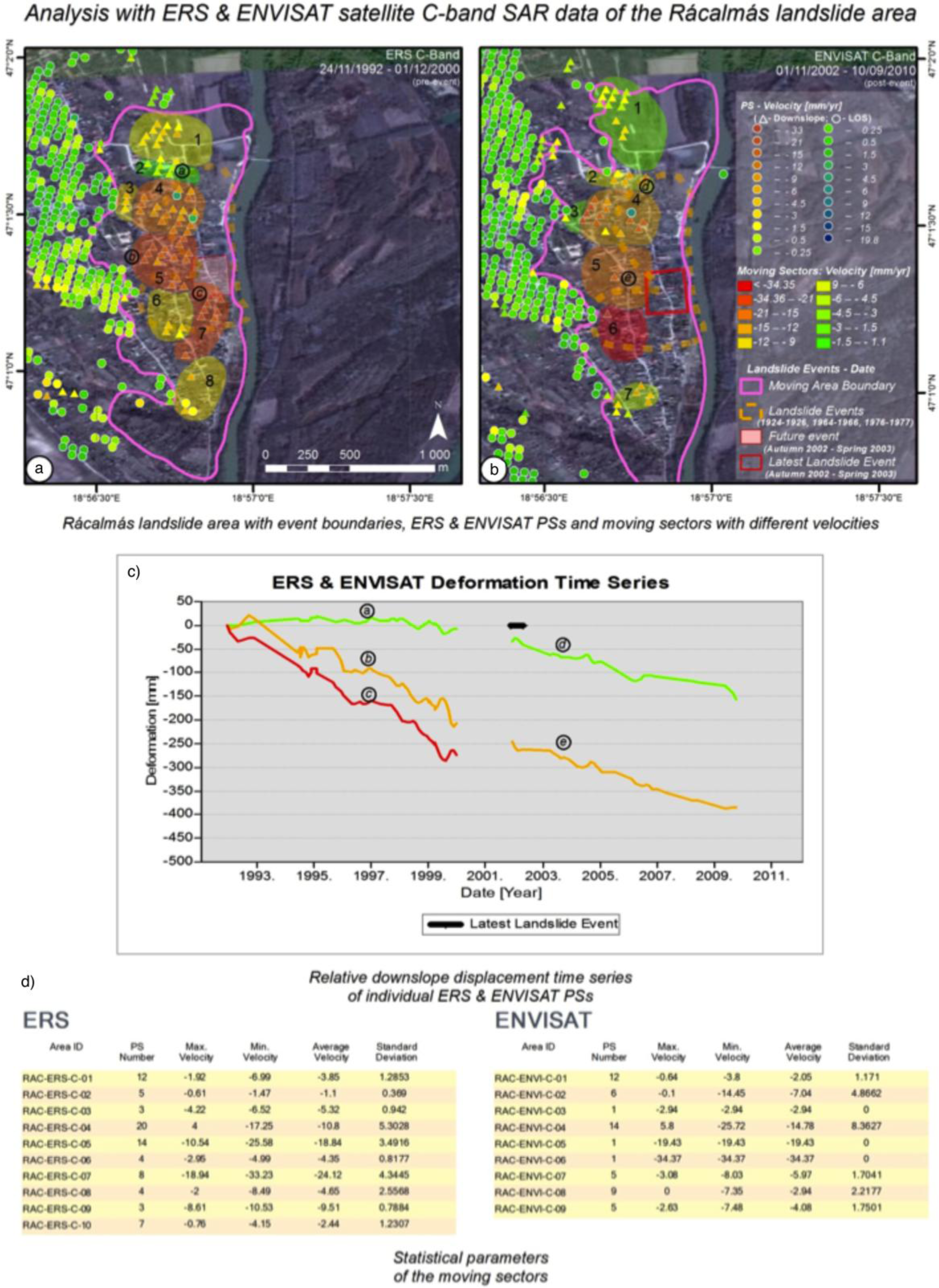

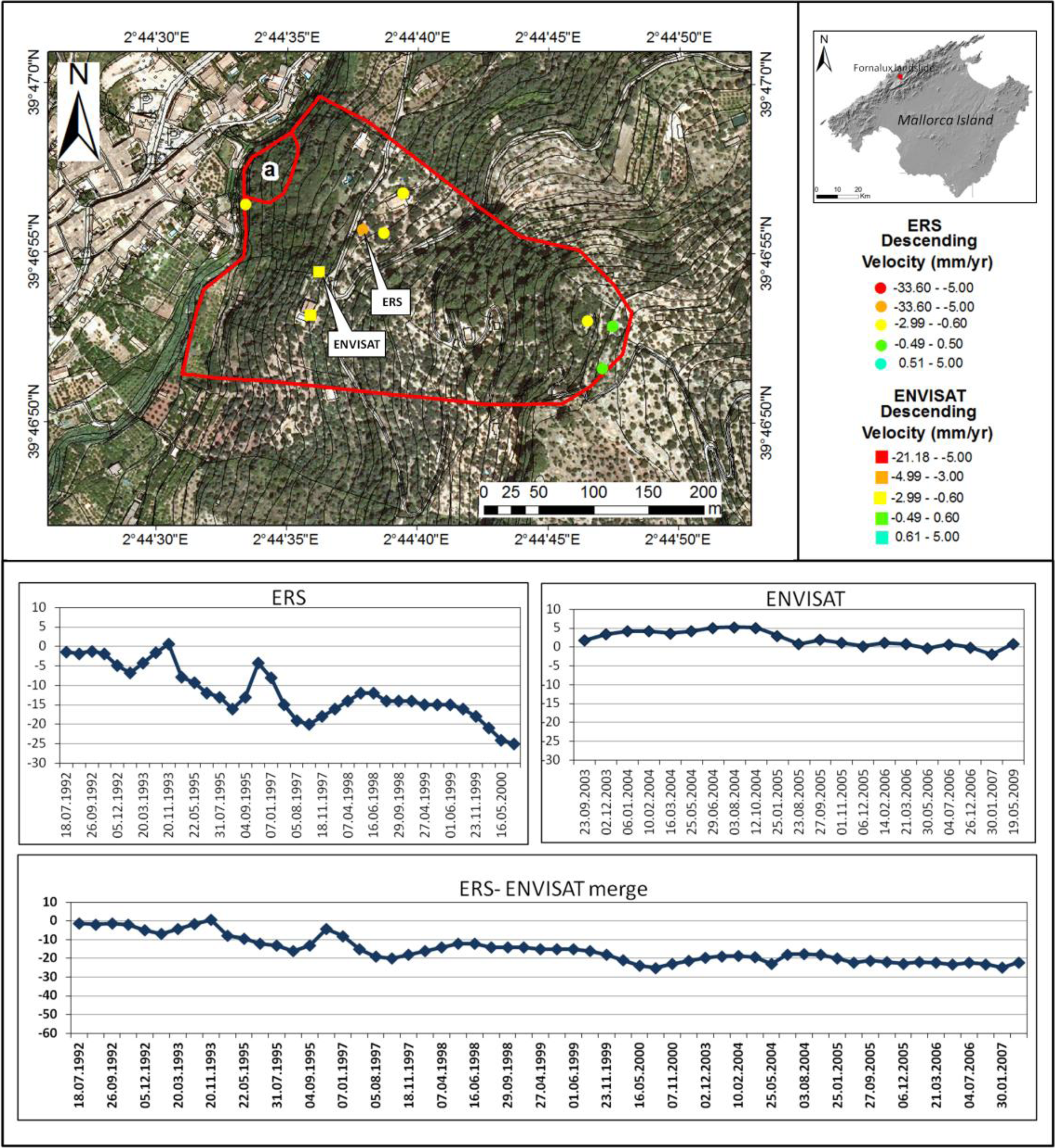
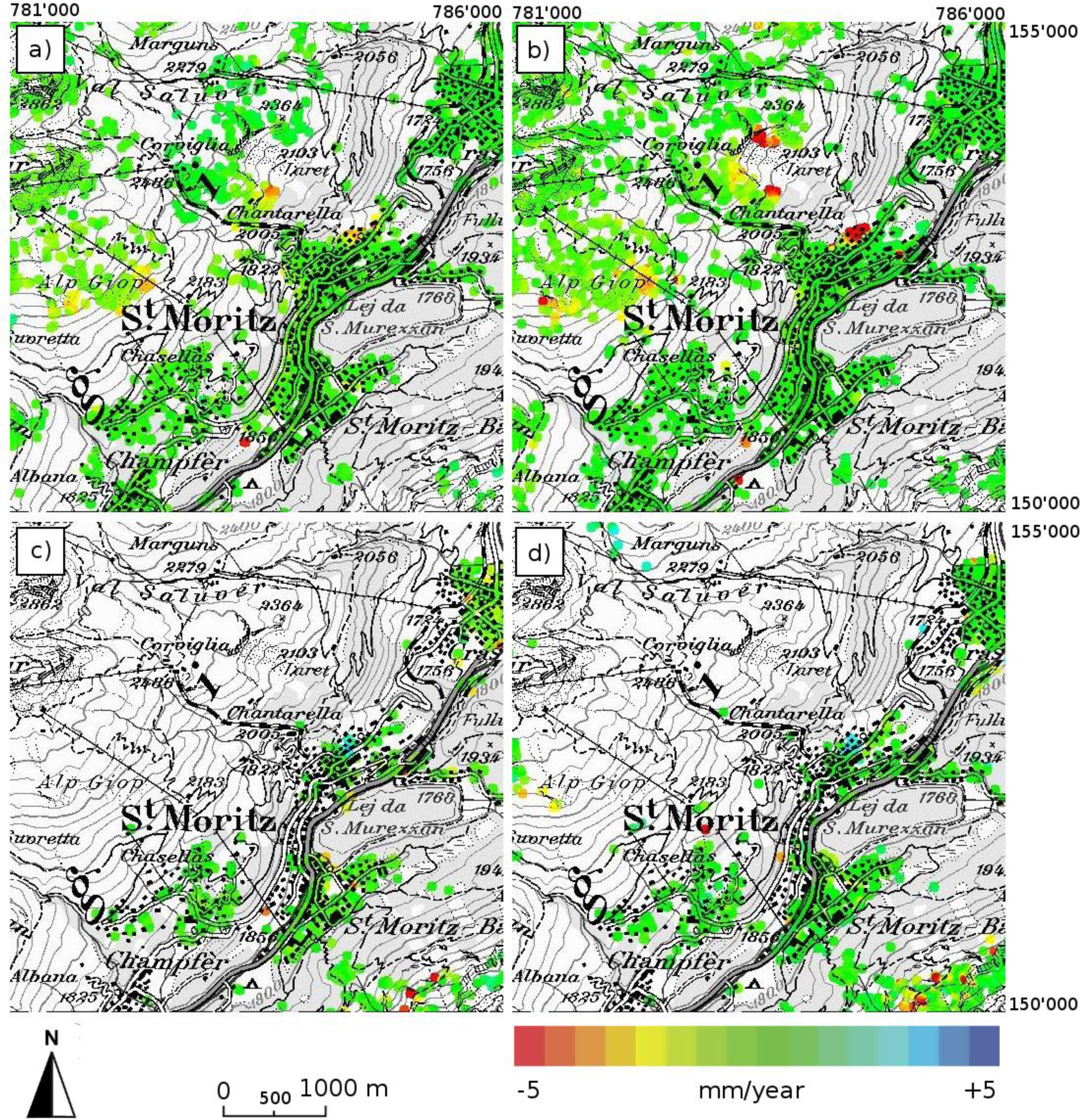
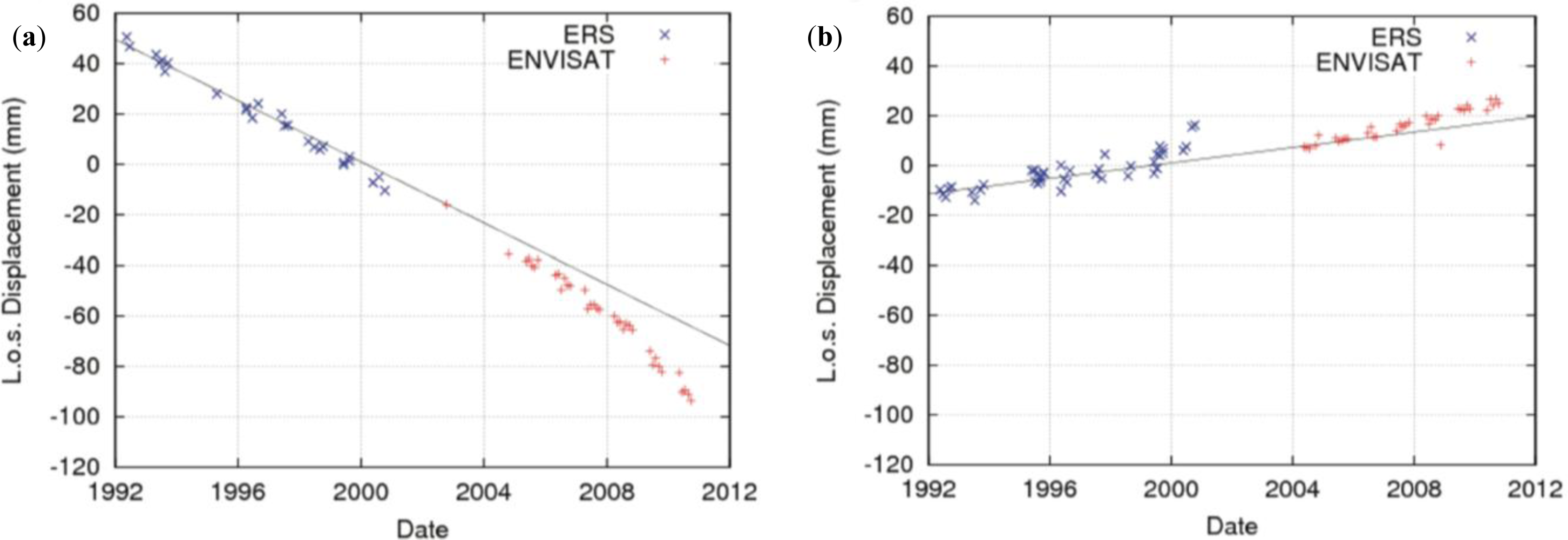
| Country | Area | Phenomena |
|---|---|---|
| Italy | Central Umbria | Subsidence and Landslide (Ivancich) |
| Messina Province (Sicily) | Landslide (San Fratello) | |
| Hungary | Danube Riverbank | Landslide (Rácalmás) |
| Poland | Silesian Coal Basin | Subsidence |
| Spain | Tramuntana Range (Mallorca) | Landslide |
| Switzerland | St. Moritz | Landslide |
| Test Site | Satellite | Orbit | Start date | End date | Image # | |
|---|---|---|---|---|---|---|
| Country | Location | |||||
| Italy | Central Umbria | ERS | Ascending | 1995.06.30 | 2006.11.25 | 36 |
| Descending | 1992.04.21 | 2010.11.12 | 91 | |||
| ENVISAT | Ascending | 2002.11.16 | 2010.09.25 | 51 | ||
| Descending | 2003.10.10 | 2010.09.03 | 39 | |||
| Messina Province (Sicily) | ERS | Ascending | 1992.09.11 | 2000.06.05 | 34 | |
| Descending | 1992.05.01 | 2001.01.08 | 70 | |||
| ENVISAT | Ascending | 2003.01.22 | 2010.09.22 | 65 | ||
| Descending | 2003.07.07 | 2010.09.13 | 49 | |||
| Hungary | Rácalmás | ERS | Descending | 1992.11.24 | 2000.12.01 | 56 |
| ENVISAT | Descending | 2001.11.01 | 2010.09.10 | 35 | ||
| Poland | Silesian Coal Basin | ERS | Descending | 1992.05.17 | 2000.12.20 | 70 |
| ENVISAT | Descending | 2003.03.05 | 2010.09.29 | 31 | ||
| Spain | Tramuntana Range (Mallorca) | ERS | Descending | 1992.06.13 | 2000.11.07 | 39 |
| ENVISAT | Descending | 2003.08.19 | 2009.05.19 | 22 | ||
| Ascending | 2003.11.22 | 2010.04.24 | 25 | |||
| Switzerland | St. Moritz | ERS | Ascending | 1992.05.16 | 2000.10.10 | 26 |
| Descending | 1992.06.04 | 2000.10.29 | 41 | |||
| ENVISAT | Ascending | 2002.10.15 | 2010.09.28 | 36 | ||
| Descending | 2004.05.16 | 2010.10.17 | 35 | |||
© 2013 by the authors; licensee MDPI, Basel, Switzerland This article is an open access article distributed under the terms and conditions of the Creative Commons Attribution license ( http://creativecommons.org/licenses/by/3.0/).
Share and Cite
Del Ventisette, C.; Ciampalini, A.; Manunta, M.; Calò, F.; Paglia, L.; Ardizzone, F.; Mondini, A.C.; Reichenbach, P.; Mateos, R.M.; Bianchini, S.; et al. Exploitation of Large Archives of ERS and ENVISAT C-Band SAR Data to Characterize Ground Deformations. Remote Sens. 2013, 5, 3896-3917. https://doi.org/10.3390/rs5083896
Del Ventisette C, Ciampalini A, Manunta M, Calò F, Paglia L, Ardizzone F, Mondini AC, Reichenbach P, Mateos RM, Bianchini S, et al. Exploitation of Large Archives of ERS and ENVISAT C-Band SAR Data to Characterize Ground Deformations. Remote Sensing. 2013; 5(8):3896-3917. https://doi.org/10.3390/rs5083896
Chicago/Turabian StyleDel Ventisette, Chiara, Andrea Ciampalini, Michele Manunta, Fabiana Calò, Luca Paglia, Francesca Ardizzone, Alessandro Cesare Mondini, Paola Reichenbach, Rosa Maria Mateos, Silvia Bianchini, and et al. 2013. "Exploitation of Large Archives of ERS and ENVISAT C-Band SAR Data to Characterize Ground Deformations" Remote Sensing 5, no. 8: 3896-3917. https://doi.org/10.3390/rs5083896
APA StyleDel Ventisette, C., Ciampalini, A., Manunta, M., Calò, F., Paglia, L., Ardizzone, F., Mondini, A. C., Reichenbach, P., Mateos, R. M., Bianchini, S., Garcia, I., Füsi, B., Deák, Z. V., Rádi, K., Graniczny, M., Kowalski, Z., Piatkowska, A., Przylucka, M., Retzo, H., ... Guzzetti, F. (2013). Exploitation of Large Archives of ERS and ENVISAT C-Band SAR Data to Characterize Ground Deformations. Remote Sensing, 5(8), 3896-3917. https://doi.org/10.3390/rs5083896











